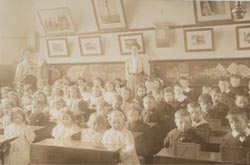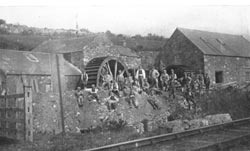Slate - Writing Slates
Writing slate production has a long history going back to the 18th century.
In 1778, Thomas Pennant states in his book Tours in Wales:
| The number of writing slates manufactured and exported from Port Penrhyn for
the last twelve months, is 136,000; the consumption of timber in this very
trifling article is upwards of 3000 feet in the year; and the number of workmen
employed are from 25-30. |
 At the beginning of the twentieth century writing slate manufacture was one
of the major markets for slate. At the beginning of the twentieth century writing slate manufacture was one
of the major markets for slate.
Whilst roofing slates accounted for most slate production, in many ways
writing slate manufacture was more sophisticated. The number of stages in the
production of a writing slate was infinitely greater. Writing slates were
produced in facilities that could be described as factories, and not just slate
mills.
Whereas roofing slate was produced at or near the quarry, writing slates were
often produced in nearby towns or villages. Bangor in 1880 had no fewer that
five producers of writing slate operating within the city.
 Writing slates were available in many designs: lined slates, slates divided
into with squares, slates with maps, two and three-leafed slates. (The writing
slate equivalent of a book.) Writing slates were available in many designs: lined slates, slates divided
into with squares, slates with maps, two and three-leafed slates. (The writing
slate equivalent of a book.)
The main advantage of writing slates was economy. They were ideal for
practising handwriting or drawing. Errors would be erased, and work resumed.
One reason why slates became less popular was the issue of hygiene. For
instance, it was not unknown for children to spit on their slate before wiping
the slate in order to clean it.
|